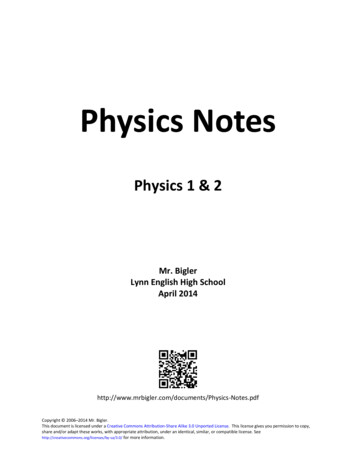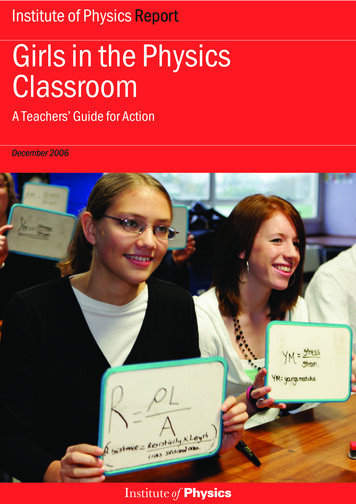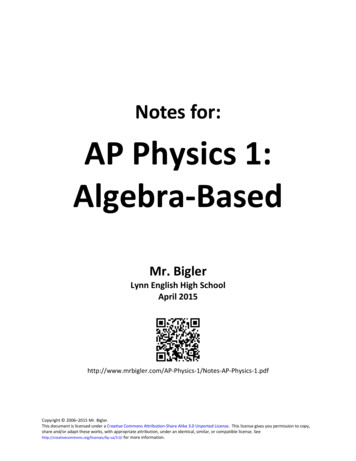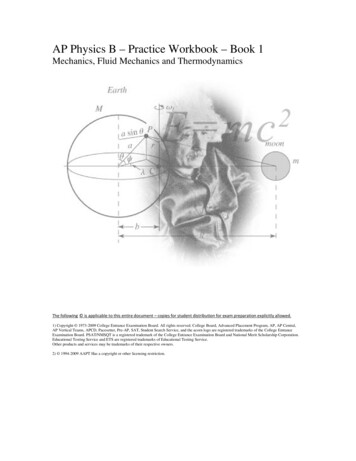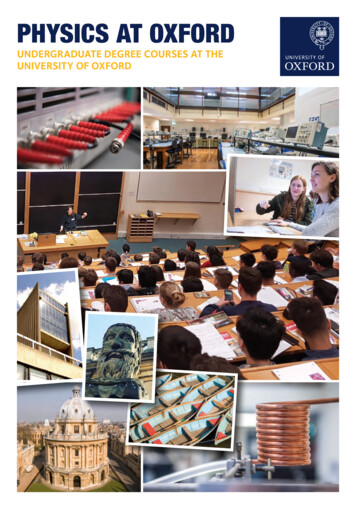
Transcription
A-Level PhysicsRevision notes 2015
ContentsUnits, Quantities and Measurements . 3Vectors and Scalars and Linear Motion . 5Equations of Motion . 9Projectiles. 9What if velocity and acceleration are in opposite directions? . 10Equations . 10Symbols . 11Circular Motion . 12Forces . 16Momentum and Impulse. 18Moments, Couples and Equilibrium . 20Work, Energy and Efficiency . 24Power and Internal Energy . 26Current, Charge and Voltage . 28Resistance . 33Kirchoff's Laws and Potential Dividers . 38Power and Energy . 40Alternating Currents . 41Capacitors . 43Magnetic Fields . 46Forces in Magnetic Fields . 50Electromagnetic Induction. 54Lenz's Law . 56Transformers and Rectification . 57Simple Harmonic Motion and Damping . 59Reflection, Refraction and Polarisation. 63Diffraction . 66Progressive Waves. 69Electromagnetic Waves. 711
Matter and Antimatter. 73Particle Classification and Interactions . 74Atomic Structure . 76Radioactivity . 78Radioactive Decay Equations . 80Nuclear Energy . 81Deformation of Solids. 82Hooke's Law . 82Energy in deformations. 83Equations . 83Symbols . 84Glossary. 84Stress and Strain. 86Temperature and Thermal Properties . 91Thermodynamics and Ideal Gases . 95Kinetic Theory . 97Quantum Physics . 100Wave Particle Duality and Electron Energy Levels . 103Electric Fields and Forces . 105Gravitational Fields and Forces . 107Electro-magnetic Waves . 109These notes cover the main areas of this subject. Please check the specific areas you need with your examboard. They are provided “as is” and S-cool do not guaranteed the suitability, accuracy or completeness of thiscontent and S-cool will not be liable for any losses you may incur as a result of your use or non-use of thiscontent. By using these notes, you are accepting the standard terms and conditions of S-cool, as stated in the scool website (www.s-cool.co.uk).2
Units, Quantities and MeasurementsBase unitsAll units in science are derived from seven base ntampereAAmountmolemolTemperatureKelvinKLight IntensitycandelacdDerived unitsThere are many other units that we use, but all of these are derived by multiplication or division of somecombinations of the base units.You can think of it like letters and words. We have 26 letters in the alphabet but we have thousands of words inour language. Here are some of the derived units:QuantityUnitSymbolBase unit equivalentVelocitymetre per secondms-1ms-1Accelerationmetre per second squared ms-2ms-2ForceNewtonNkg ms-2Work or Energy jouleJkg m2s-2PowerwattWkg m2s-3PressurePascalPakg m-1s-2FrequencyhertzHzs-1ChargecoulombCAsPrefixes3
Now you have units, you often need to group these into larger or smaller numbers to make them moremanageable. For example, you don't say that you are going to see someone who lives 100,000 m away fromyou; you say they live 100 km away from you.Here a quick list of the common quantities used:NameSymbolScaling factorCommon exampleteraT10121,000,000,000,000 Large computer hardrives can be terabytes in size.gigaG109 1,000,000,0006Computer memories are measured in gigabytes.mega M10 1,000,000A power station may have an output of 600 MW (megawatts).kilo103 1,000Mass is often measured in kilogrammes (i.e. 1000 grammes).decikd-1Fluids are sometimes measured in decilitres (i.e. 0.1 litre).-210 0.1centi c10 0.01Distances are measured in centimetres (i.e. 100th of a metre).milli10-3 0.001Time is sometimes measured in milliseconds.micro µ10-6 1,000,000thmicrometres are often used to measure wavelengths of electromagneticwaves.nano n10-9nanometres are used to measure atomic spacing.picomp10-12picometres used to measure atomic radii.4
Vectors and Scalars and Linear MotionVectors versus ScalarsVectors and scalars are two types of measurements you can make. A scalar measurement only records the magnitude (or amount) of whatever you are measuring. A vector measurement records the magnitude of the thing you are measuring and the direction.Vector AdditionAdding scalars is easy because you can just add the numbers.For Example: 3kg 4 kg 7 kgAdding vectors needs much more care. You have to take into account their magnitude and direction.For Example: What are 3N 4N? Well, it depends on the directions! Look at the possibilities.So in other words, you add vectors geometrically (using geometry). You should be able to do this using accuratediagrams (don't forget your protractor) or by using Pythagoras.5
Resultant VectorsThe resultant vector is the one that you get when you add two or more vectors together. It is a single vector thathas the same effect as all the others put together. Finding the resultant vector when the forces are in differentdirections can be tricky if you don't like Pythagoras, so here's a couple to get you going!Worked Example:Using Pythagoras: R2 82 72So, R 113 10.6 NResolving Vectors into ComponentsWe have just shown that any two vectors can be represented by a single resultant vector that has the sameeffect. Guess what?! You can do the same thing in reverse! Any single vector can be represented by two othervectors (components), which would have the same effect as the original one:You need to use trigonometry to find the two components of a vector. Remember the two components willalways be at right angles.6
Check that you understand how to calculate the values of the components.Speed and VelocityBoth speed and velocity tell us how far something is travelling in unit time. As velocity is a vector it must also tellus what direction the object is travelling in.distance moved (m)Speed (m/s) time taken (s)displacement change (m)Velocity (m/s) time taken (s)AccelerationAcceleration tells us how rapidly something is changing speed - for instance, the change in speed in unit time.Deceleration is the same thing, but we give it a negative sign as the speed will be decreasing.Change in velocity (m/s)Acceleration (m/s2) time taken (s)Displacement-time graphsThese show the motion of an object very clearly and allow you to find position and velocity at any time. Anygraph that you see will be a combination of these sections.7
Change in DNotice that the gradient the velocity at any time.Change in tWhen the velocity is changing, as on the lower two graphs, you can find the velocity at any point by drawing atangent touching the graph at that point by drawing a tangent touching the graph at that point and working outits gradient using the same equation.Velocity-time graphsThese fare similar to displacement-time graphs, but this time velocity is on the y-axis. Here are the onlypossibilities that you'll come across at A-level.Change in velocityNotice that the gradient acceleration or deceleration.Change in timeYou also need to know that the area under the line gives you the displacement of the object up to that point.Acceleration-time graphsNote: All three of the movement graphs are related to each other as the: Gradient of D/t graph gives you the points on the v/t graph. Gradient of v/t graph gives you the points on the a/t graph.8
Equations of MotionIf acceleration is constant, a quicker way than drawing graphs to find acceleration, velocity or displacementis to use some equations.The symbols for displacement, initial velocity, etc. are shown on the diagram.ProjectilesVectors at right angles to one another are independent.If you are considering the effect of two (or more) vectors on an object, it is important to remember that:Vectors at right angles to each other do not have any effect on each other.An easy example: no matter how hard you push down on an object, you will never make it accelerate sideways.Projectile Motion - ignoring frictionIf a stone is thrown horizontally from a cliff top it follows what is called projectile motion.Vertically it has constant acceleration downwards (due to gravity).Horizontally it has constant velocity (for instance, no acceleration or deceleration if there is no friction).Some useful tricks:To find out about the ball at the highest point in its flight, remember that at that point vertically: v 0 m/s.(For that instant it is travelling horizontally so it has no vertical velocity at all).To find the time for the whole flight you usually have to find the time for half the flight by considering the timefor the vertical velocity to reduce to zero from its initial value (for instance, the time it takes the ball to stopmoving any higher) and then double it.9
What if velocity and acceleration are in opposite directions?Direction is importantTo show different directions we use a positive or negative sign. It doesn't matter whether you choose up ordown, left or right as positive, as long as you stick to it for the rest of the question.For example:If you are going to the right at 10ms-1 but accelerating to the left (for instance, decelerating) at 2ms-2, then u 10ms-1 and a -2ms-2Acceleration due to gravityObjects in a gravitational field experience a downward force, their weight. If unbalanced, this will produce adownward acceleration. This crops up frequently in A-level questions. However, it's easy to deal with. Simplyalways use acceleration as:a g 9.81 ms-2 downwards.For example:Drop a stone from a cliff.Initially, t 0, u 0, and a 9.81 ms-2 (Note: I've chosen down to be positive here)OrThrow a stone upwards at 10 ms-1Initially, t 0, u 10ms-1 and a g -9.81ms-2. (Note: I've chosen up to be positive here to show that itdoesn't matter which one you choose as long as you're consistent.)EquationsEquations of MotionLearn to derive and usev2 u2 2 asv u ats ut ½ at210
Symbolss displacementu initial velocityv final velocitya accelerationt timeg acceleration due to gravity, 9.81 ms-211
Circular MotionForces in circular motionNote: Put your calculator into radians mode before using circular motion equations!Remember Newton's First law?"If an object continues in a straight line at constant velocity, all forces acting on the object are balanced."Or another way of putting it."An object at rest tends to stay at rest and an object in motion tends to stay in motion with the same speed andin the same direction unless acted upon by an unbalanced force."Objects moving in circular motion clearly aren't going in a straight line so the forces can't be balanced.There is a resultant force. This is called the centripetal force.The centripetal force is always directed towards the centre of the circle (along the radius of the circle).Angular acceleration and centripetal forceIf an object is moving with constant speed in circular motion, it is not going at constant velocity. That's becausevelocity is a vector. Although its magnitude remains the same, its direction varies continuously.This resultant force, the centripetal force, causes the centripetal acceleration. It is always at 90ο to the directionof movement of the object - and that's why the object doesn't speed up!Centripetal acceleration can be calculated using:12
Where:v velocity (m/s)a centripetal acceleration (m/s2)r radius of the circle (m)And from Newton's Second Law:F ma, soThis is an equation for centripetal force.Vertical circlesWhen an object is moving in circles that are vertical, its weight has to be taken into consideration.Note: If you are using v ω r in your syllabus, you can substitute this into the equations for centripetal forceand acceleration to find values using angular velocity.Angles in radiansThe radius of a circle and its circumference are related by the equation.Circumference 2πrAs long as you use angles in radians you can write this general equation:s rθWhere:s arc length coveredr radius of circleθ angle in radians13
Angular speedIn linear or straight-line motion, we measure speed by looking at how much distance is covered each second.You can do that in circular motion too, but it's often better to use angular speed, ω.Angular speed measures the angle of a complete circle (measured in radians) you cover per second.For instance,Where:θ angle in radianst time taken in seconds.If you consider that the time taken for a complete rotation is the period, T, thenbecause 2 is the angle covered (in radians) when you do a complete circle.Remembering thatyou can also write this asω 2πfThe relationship between angular speed and linear speedIf you are going round in a circle of radius, r, and you are travelling at a linear speed, v ms-1:The distance covered in 1 rotation 2πrThe time for one rotation T, the period.Linear speedSo, v 2&rf and w 2pf orSo we can relate angular and linear speed.Equationsω 2πf14 w and v wr
v rωSymbolsω angular speed, rad s-1f frequency, Hz (No. of rotations per second)T the period of rotation, sv linear speed, ms-1r radius of rotation, ma centripetal acceleration, ms-2F centripetal force, N15
ForcesThe BasicsForces are vectors, so we can find a resultant force on an object, no matter how many forces are acting on it. Ifthe resultant force is zero, the forces must be balanced.Balanced forces cause no acceleration (This means that the object will remain stationary or carry on movingat a constant velocity.)If the resultant force is not zero the forces are unbalanced. Unbalanced forces cause acceleration in thedirection of the resultant force.Every force has a partner force that is the same size but acts in the opposite direction on another object.Calculating forceF maWhere:F force (N)m mass (kg)a acceleration (m/s2)Newton's first law of motion"Bodies will continue to move with a uniform velocity (which includes being stationary) unless acted on by aresultant force."Newton's second law of motion"Resultant force is equal to the rate of change of momentum."This forms the basis of Newton's equation, F ma.Newton's third law of motion"Every force acting on an object has an equal and opposite force which acts on another object."FrictionFriction is caused by rubbing. It can be the surfaces between two solids rubbing, a solid surface and a liquidor a gas, etc. Anything! When friction is caused by fluids (liquids or gases) we tend to call it drag or airresistance.16
"Friction dissipates energy." That means that energy moves from kinetic energy to heat energy, where it islost to the surroundings.Terminal velocityFor a falling object, when the air resistance force up has grown so big that it matches the weight down there isno resultant force and therefore no acceleration. The object will travel at a constant speed. This is calledthe terminal velocity.It's not just falling objects that have a terminal velocity. You have one when you run! Think about it.PressurePressure is caused by forces acting on a surface. The greater the force or the smaller the surface area, thegreater the pressure produced.We can calculate pressure using:Where:P pressure (N/m2 or Pa, Pascals) - Note: 1 Pa 1 N/m2F force (N)A surface area (m2)Transmitting forcesSolids can transmit forces easily. If you push one end of a metal bar the other end will push whatever isnear to it in the same direction. Liquids and gases can't do this.Pressure is useful because it can be used to transmit forces from one place to another using liquidsand gases.Note: Energy can't be created from nowhere, so the small area will have to move down much further than thelarger area moves up!This idea is used in hydraulic systems - for example, car brakes. A person puts a small force onto the footpedal, which creates a large force on the car brakes pads.17
Momentum and ImpulseDefinition of momentumLinear momentum, P, is defined as the mass, m, of an object multiplied by its velocity, v, so:P mvUnits: kgms-1 or Ns(Sometimes momentum is given the symbol M). Momentum is a vector.Principle of the conservation of momentumThe Principle of the Conservation of Momentum states that: if objects collide, the total momentumbefore the collision is the same as the total momentum after the collision (provided that no external forces - forexample, friction - act on the system).That's amazingly useful because it means that you can tell what is going to happen after a collision before it hastaken place.Principle of Conservation of Energy: Of course, energy is also conserved in any collision, but it isn't alwaysconserved in the form of kinetic energy, so be careful.So what is its momentum afterwards?Defining forceForce can be defined as the rate of change of momentum as:Perfectly Elastic collisions(A special case) All momentum is conserved (not surprisingly - it always is!) Kinetic energy is conserved (that's what makes this special). Relative speed of approach relative speed of separation.Perfectly Inelastic collisions(Another special one)18
All momentum is conserved (as always). Kinetic energy is not conserved. The relative speed of separation is zero.Inelastic collisions(The usual old case) All momentum is conserved (again). Kinetic energy is not conserved (again). You can't say anything about the speed at which they leave each other without doing a calculation.Changing momentumFrom Newton's Second Law and the definition of force:(mv final momentum, mu initial momentum)To achieve any particular change in momentum, you can either have a large force multiplied by a small timeor a small force multiplied by a large time.Change in momentum is called impulse,So, impulse mv - mu and F hence impulse FtForce-time graphsWe can plot graphs of the force during a collision against time.We can find the impulse, or change in the momentum, by calculating the area under the force-time graph19
Moments, Couples and EquilibriumCalculating momentsFactors affecting momentsWhen you push a door closed, it doesn't travel in a straight line - it turns around the hinges. This is an exampleof a moment (or torque).So there are three things that are important: The size of the force. The direction of the force. The distance from the force to the hinge.Definition of Moments (or Torque)"A moment is defined as a force multiplied by the perpendicular distance from the line of action ofthe force to the pivot."Units: Nm. Symbol, M (or sometimes T)Principle of MomentsFor equilibrium:The sum of the clockwise moments about a point sum of the anticlockwise moments about that point.CouplesIf you have two forces (for instance, a couple of forces) acting on an object and the forces are: parallel in opposite directions of equal size not along the same line of action.you have got a couple.20
21
Equilibrium ConditionsYou need to check that two conditions are satisfied before you can say that something is in equilibrium. The sum of the forces in any direction 0. If this is satisfied, the object will have no linear acceleration (forinstance, it won't accelerate in any direction). The sum of the moments about any point (not just the pivot point) 0. If this is satisfied, there is no angular (orcircular) acceleration (for instance, the object won't rotate faster or slower.)We write these two in short hand as:ΣF 0ΣM 0Triangle of ForcesThis is a quick way of finding out if the forces acting on an object are in equilibrium.This object experiences three forces.If it is in equilibrium then drawing accurate vector diagrams of each force one after the other will produce a closedtriangle.Centre of Gravity (and Centre of Mass)Why is it useful?When doing moment calculations you can say that all the weight of an object acts through the Centre of Gravity.What's the difference between Centres of Gravity and Mass?Centre of Gravity the point where all the weight seems to be concentrated.Centre of Mass the point where all the mass seems to be concentrated.Where can you find the Centre of Gravity?22
For regular shapes it is the geometrical centre of the object - for example, the centre of a cube or a sphere.For irregular shapes, hang the object from a point on its edge and the Centre of Gravity will end up verticallybelow the point you are hanging it from.23
Work, Energy and EfficiencyDefine workEnergy can be quite difficult to understand, but can be thought of as 'the capacity of a body to do work'.The Principle of Conservation of EnergyNothing to do with turning off your stereo when you leave a room. This fundamental piece of science says thatyou cannot destroy or create energy. (If you find a way - keep it quiet until you have taken out a patent - andyou'll be a rich person!)People often say that you use up energy. That is misleading because it suggests that once it is used you can'tget it back. In fact, when you use energy, you are simply converting it into other forms of energy - so it is stillout there it is just no longer in the nice, useful form that you had it in a moment before.Quite often if you can't quite put your finger on where the energy has gone (i.e. what form you have turned itinto) you have turned it into heat, which is lost to the surroundings.EfficiencyA light bulb is designed to turn electrical energy into light energy. But most bulbs produce a lot of heat energytoo. That energy has not been lost but it has been wasted -you don't say "It's cold in here. Turn on the light!" doyou.To measure the efficiency of a device, calculate what percentage of the total energy put in, became usefuloutput energy.The Work EquationAt the heart of energy is the equation:Work force x distance moved in the direction of the forceOrW FsThe point that causes the most confusion here is that the distance moved is actually a vector because itsdirection is important.Kinetic EnergyK.E. ½ mv2Units: J, joulesKinetic energy stored in an object that is moving equals the amount of work done accelerating it to that speed.24
Gravitational Potential EnergyEp P.E. mghUnits: J, joulesPotential Energy is the energy stored in objects which have been lifted against a gravitational field (or in fact amagnetic or electric field - see later).Equations and DefinitionsW FsWork force x distance moved in the direction of the forceEp mghU Ek EpSymbolsW work done, JF force, Ns displacement, mt time, sv velocity, ms-1K.E. or Ek kinetic energy, JEp potential energy, J25
Power and Internal EnergyPowerWork done mghPower is defined as the rate at which you do work.Units: W, watts. 1 watt 1 joule per second ( 1 Js-1)The equation is:Power Work Done / Time TakenAnother useful equation can be derived from this. Notice that:Work done, W force x displacement FsSo power orAndSo P FvSo Power Force x velocity; remembering that the force and velocity must be in the same direction.Internal energyIf you look at the atoms that make up everything or anything, they are moving around (more at highertemperatures) and feeling forces acting on them due to their neighbours (attraction and repulsion).This means that the atoms themselves have got kinetic energy (K.E.) and potential energy (P.E.). This is knownas the atoms internal energy.You need to know that the internal energy, U, of a substance is made up of two components.U K.E. P.E. Ek EpEquations and DefinitionsW FsWork force x distance moved in the direction of the force26
Power is the rate at which you do work.Ep mghU Ek EpSymbolsW work done, JF force, Ns displacement, mt time, sv velocity, ms-1K.E. or Ek kinetic energy, JEp potential energy, Ju internal energy, J27
Current, Charge and VoltageChargeCharge is a property of certain particles. A particle with charge will experience a force in an electric field (orin a magnetic field if the charge is moving).Charge is either positive or negative. Objects with a similar charge will repel. Objects with opposite chargeswill attract.Charge is measured in coulombs, C. The amount of charge on an object can be found using a coulombmeter.An electron always has a negative charge of -1.6 x 10-19 coulombs. Protons have an equal amount of positivecharge. One coulomb is equal to the charge on 6.25 x 1018 electrons, which is a serious number of electrons.The Conservation of ChargeIt is not possible to destroy or create charge.You can cancel out the effect of a charge on
5 Vectors and Scalars and Linear Motion Vectors versus Scalars Vectors and scalars are two types of measurements you can make. A scalar measurement only records the magnitude (or amount) of whatever you are measuring. A vector measurement records the magnitude of the thing you are measuring and the direction. Vector Addition


